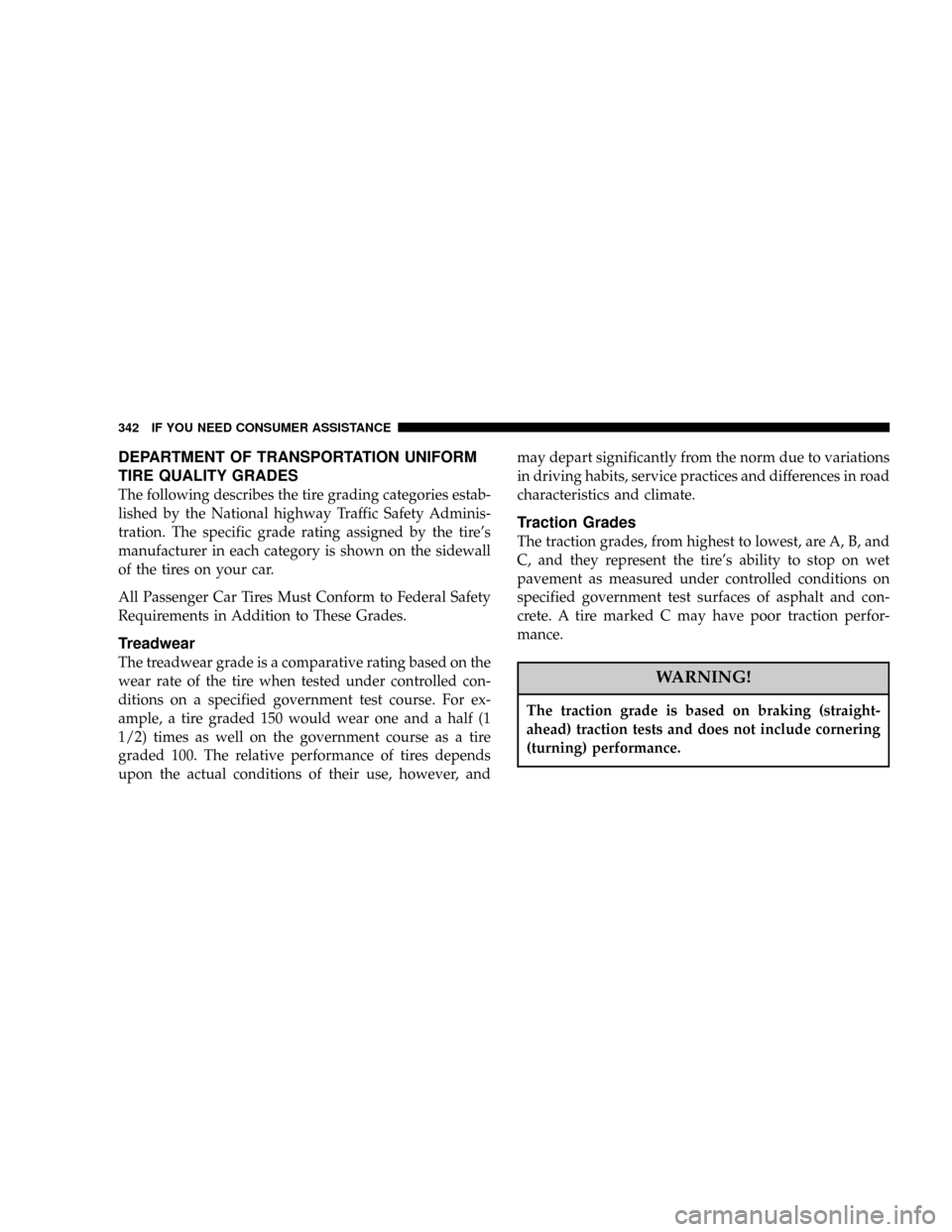climate control CHRYSLER PACIFICA 2004 1.G Owners Manual
[x] Cancel search | Manufacturer: CHRYSLER, Model Year: 2004, Model line: PACIFICA, Model: CHRYSLER PACIFICA 2004 1.GPages: 361, PDF Size: 5.21 MB
Page 29 of 361

²The power liftgate must be in the full open position for
any of the close buttons to operate. If the liftgate is not
fully open, press the open button to fully open the
liftgate and then press close.
²If the liftgate release switch is activated while the
power liftgate is closing, the liftgate will reverse to the
full open position.
²The power liftgate switches will not operate if the
vehicle is in gear or the vehicle speed is above 0 mph
(0 km/h).
²The power liftgate will not operate in temperatures
below222ÉF(230É C) or temperatures above 150É F
(65É C). Be sure to remove any build-up of snow or ice
from the liftgate before pressing any of the power
liftgate switches.
²If the power liftgate encounters multiple obstructions
within the same cycle, the system will automatically
stop and must be opened or closed manually.
WARNING!
²Driving with the liftgate open can allow poison-
ous exhaust gases into your vehicle. You and your
passengers could be injured by these fumes. Keep
the liftgate closed when you are operating the
vehicle.
²If you are required to drive with the liftgate open,
make sure that all windows are closed, and the
climate control blower switch is set at high speed.
DO NOT use the recirculation mode.
THINGS TO KNOW BEFORE STARTING YOUR VEHICLE 29
2
Page 62 of 361

SAFETY TIPS
Exhaust Gas
WARNING!
Exhaust gases can injure or kill. They contain carbon
monoxide (CO) which is colorless and odorless.
Breathing it can make you unconscious and can
eventually poison you. To avoid breathing (CO)
follow the safety tips below.
Do not run the engine in a closed garage or in confined
areas any longer than needed to move your vehicle in or
out of the area.
If it is necessary to sit in a parked vehicle with the engine
running, adjust your heating or cooling controls to force
outside air into the vehicle. Set the blower at high speed.
WARNING!
If you are required to drive with the liftgate open,
make sure that all windows are closed, and the
climate control blower switch is set at high speed.
DO NOT use the recirculation mode.
Safety Checks You Should Make Inside The
Vehicle
Seat Belts
Inspect the belt system periodically, checking for cuts,
frays and loose parts. Damaged parts must be replaced
immediately. Do not disassemble or modify the system.
Front seat belt assemblies must be replaced after a
collision. Rear seat belt assemblies must be replaced after
a collision if they have been damaged (bent retractor, torn
webbing, etc. If there is any question regarding belt or
retractor condition, replace the belt.
62 THINGS TO KNOW BEFORE STARTING YOUR VEHICLE
Page 135 of 361

mNavigation System Ð If Equipped...........182
mClimate Controls.......................183NDual-Zone Automatic Temperature Control . . . 183
NElectric Rear Window Defroster...........193
UNDERSTANDING YOUR INSTRUMENT PANEL 135
4
Page 183 of 361

To replace the navigation map DVD lift the storage bin
cover and liner in the rear cargo area, press the eject
button and the disc will eject. Gently insert the new disc
into the DVD unit with the label facing up. The disc will
automatically be pulled into the DVD unit.
CLIMATE CONTROLS
The Air Conditioning and Heating System is designed to
make you comfortable in all types of weather.
Dual-Zone Automatic Temperature Control
The Dual Zone Automatic Temperature Control (ATC)
System automatically maintains the interior comfort level
desired by the driver and front seat passenger. This is
accomplished by using two infrared sensors located in
the center of the instrument panel. The two infrared
sensors independently measure the surface temperature
of the driver and front seat passenger. Based on the
sensor input, the system automatically adjusts the airtemperature, the airflow volume, the airflow distribu-
tion, and amount of inside air recirculation to maintain
front seat occupant comfort, even under changing out-
side weather conditions.
To operate the system, press either the9AUTO HI9or
9AUTO LO9buttons. The system now automatically
UNDERSTANDING YOUR INSTRUMENT PANEL 183
4
Page 190 of 361

A/C Recirculation Programming
The recirculation control is programmed to cancel the
recirculation mode when the ignition key is turned OFF
and will reset to the outside air mode when the ignition
key is turned ªONº. The frequent use of outside air will
help keep odors from building up within the air
conditioner-heater housing. It is recommended that the
recirculation mode be used as little as possible, especially
in humid climates.
For hot and dry climates, or people who are allergic to
pollen and find frequent use of the recirculation mode
necessary, the recirculation mode can be programmed to
not automatically reset to the outside mode by using the
following procedures:
²Turn the ignition switch to the OFF position.
²Press and hold the recirculation button.
²While holding the recirculation button, turn the igni-
tion switch to the ªRUNº position.
²Continue holding the recirculation button for 4 sec-
onds, then release.
The recirculation control is now programmed so that the
recirculation mode willnotreset to the outside air mode
when the engine is restarted. The recirculation program-
ming can be changed back by repeating this procedure.
190 UNDERSTANDING YOUR INSTRUMENT PANEL
Page 192 of 361

Use of the air Recirculation mode during winter months
is not recommended because it may cause window
fogging.
Vacation Storage
Anytime you store your vehicle, or keep it out of service
(i.e. vacation) for two weeks or more, run the air condi-
tioning system at idle for about five minutes in the fresh
air and high blower setting. This will insure adequate
system lubrication to minimize the possibility of com-
pressor damage when the system is started again.
Window Fogging
Vehicle windows tend to fog on the inside in mild rainy
or humid weather. To clear the windows, use the A/C
button to reduce the humidity inside the vehicle.
Fogging on the inside of the windshield can be quickly
removed by pressing the defrost button and increasing
the blower speed.Do not use the Recirculation mode without the A/C
button for long periods as fogging may occur.
Outside Air Intake
Before driving, always make sure the air intake located
directly in front of the windshield is free of obstructions
such as leaves, ice, or snow, which could reduce airflow
and/or plug the water drain tube inside the plenum.
A/C Air Filter
The climate control system filters out dust, pollen and
some odors from the air. Strong odors can not be totally
filtered out. Refer to section 7 ªAir Conditioningº for
filter replacement instructions.
192 UNDERSTANDING YOUR INSTRUMENT PANEL
Page 342 of 361

DEPARTMENT OF TRANSPORTATION UNIFORM
TIRE QUALITY GRADES
The following describes the tire grading categories estab-
lished by the National highway Traffic Safety Adminis-
tration. The specific grade rating assigned by the tire's
manufacturer in each category is shown on the sidewall
of the tires on your car.
All Passenger Car Tires Must Conform to Federal Safety
Requirements in Addition to These Grades.
Treadwear
The treadwear grade is a comparative rating based on the
wear rate of the tire when tested under controlled con-
ditions on a specified government test course. For ex-
ample, a tire graded 150 would wear one and a half (1
1/2) times as well on the government course as a tire
graded 100. The relative performance of tires depends
upon the actual conditions of their use, however, andmay depart significantly from the norm due to variations
in driving habits, service practices and differences in road
characteristics and climate.
Traction Grades
The traction grades, from highest to lowest, are A, B, and
C, and they represent the tire's ability to stop on wet
pavement as measured under controlled conditions on
specified government test surfaces of asphalt and con-
crete. A tire marked C may have poor traction perfor-
mance.
WARNING!
The traction grade is based on braking (straight-
ahead) traction tests and does not include cornering
(turning) performance.
342 IF YOU NEED CONSUMER ASSISTANCE
Page 348 of 361

Cellular Phone.......................... 73
Chains, Tire............................ 233
Changing A Flat Tire..................... 252
Child Restraint.......................... 53
Child Restraint Tether Anchors.............53,55
Child Safety Locks........................ 18
Child Seat.............................. 59
Clean Air Gasoline....................... 236
Climate Control......................... 183
Clock................................ 154
Compact Disc Maintenance................. 181
Compact Spare Tire...................... 226
Compass.............................. 151
Compass Calibration..................... 152
Compass Variance....................... 152
Computer, Trip/Travel.................... 153
Console.............................. 126
Console, Floor.......................... 126
Console, Overhead....................... 114Contract, Service........................ 338
Coolant Pressure Cap..................... 289
Cooling System......................... 286
Adding Coolant (Antifreeze).............. 288
Coolant Capacity...................... 311
Coolant Level......................... 290
Disposal of Used Coolant................ 290
Drain, Flush, and Refill.................. 287
Inspection........................... 286
Points to Remember.................... 290
Pressure Cap......................... 289
Radiator Cap......................... 289
Selection of Coolant..................287,312
Cruise Control.......................... 111
Cruise Light........................... 143
Cup Holder.........................126,304
Customer Assistance..................... 336
Dealer Service.......................... 271
348 INDEX